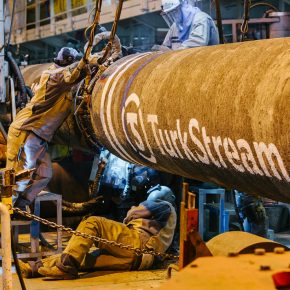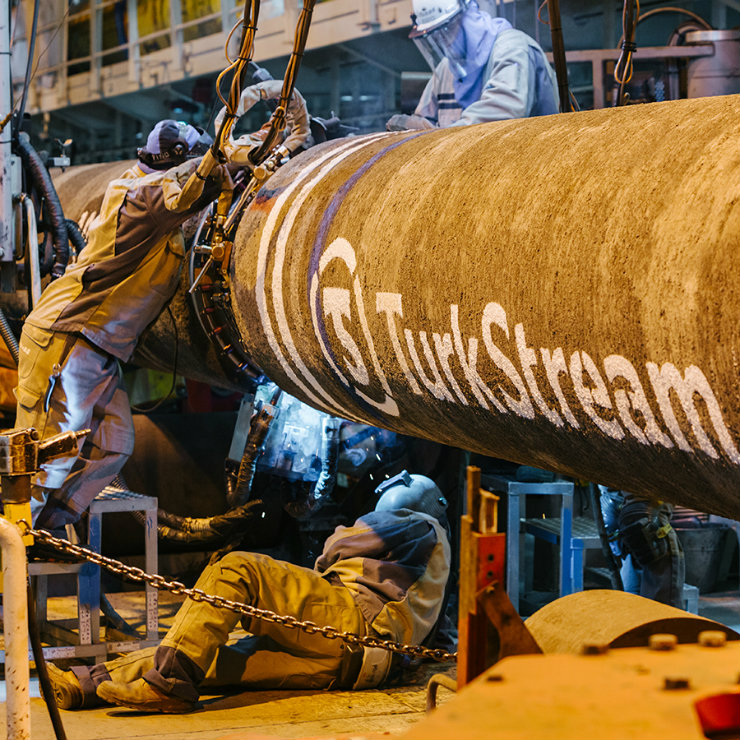Tydzień w gospodarce
Category: Raporty

(TurkStream, Public domain)
The pipeline, with a total length of 910 kilometers, helps Turkey, whose domestic energy production meets only 2 per cent of its needs, ensure stable energy supplies. According to the Turkish President Erdogan, TurkStream will be ready to operate by the end of 2019 after several tests are carried out.
Although mostly known for bringing Russian gas to Turkey, the pipeline laid underneath the Black Sea is only the first part of a much larger project. While the first section will supply the Turkish market, the second is expected to provide southern European countries with Russian gas. Both sections combined are expected to deliver 30 billion cubic meters (bcm) of gas per year.
After months of speculations regarding the precise route of the European phase of the pipeline, Russia’s energy giant, Gazprom, has reportedly made a final decision. According to the Russian business daily Kommersant, Gazprom will extend the TurkStream natural gas pipeline’s second string to Bulgaria. The gas would flow through the east Balkan state further to Serbia, Hungary and Slovakia. The first gas delivery from Turkey to Bulgaria and Serbia is supposed to take place in 2020, while Hungary will have to wait until 2021.
Bulgaria views the pipeline project as extremely important and is prepared to open talks on becoming a key part of it, Bulgarian Ambassador to the Russian Federation Atanas Krastin told Sputnik that “There is a lot of work ahead to outline how this project will develop. Bulgaria is, of course, open for these negotiations because the construction of such large-scale projects is important for all countries.”
Apart from Bulgaria and the Central European countries, there are already calls for cooperation from other corners of the continent. According to the Turkish publication Daily Sabah, the Prime Minister of Greece Alexis Tsipras wants to negotiate the issue of extending the pipeline to Greek territory.
During his recent tour around Europe, the US Energy Secretary Rick Perry called on Hungary and other states in the region to reject any form of cooperation with Russia regarding its gas pipeline projects. According to Washington, Moscow uses its energy operations to cement its grip on countries from Central and Southeast Europe. The United States’ government would like to see more diversification when it comes to partners the EU countries chose to do energy business with. “Russia is using a pipeline project Nord Stream 2 and a multi-line Turkish stream to try to solidify its control over the security and the stability of central and eastern Europe,” Mr. Perry stressed during his visit to Budapest.
Under Donald Trump’s presidency, the United States has become more vocal about its dissatisfaction with the Russian gas projects, encouraging its partners in Europe and elsewhere to buy gas from the United States instead. “The United States strongly opposes these projects and we urge Hungary and its neighbors to join us in rejecting them,” Mr. Perry added.
Although Hungary’s Foreign Minister Peter Szijjarto expressed willingness to let the US to help his country with diversification of gas supplies, Hungary has signed a deal with Russia’s Gazprom to link the country with the Turkish Stream pipeline already in June 2017.
Other European countries, including Ukraine, oppose the TurkStream’s second line, arguing that it will lead to a further monopolization of the European gas market by Russia. For this very reason, the original South Stream project was cancelled back in 2014.
The current TurkStream project has replaced the earlier South Stream Project but was stopped in November 2015, after a Russian jet fighter got shot down by a Turkish missile. The agreement for the pipeline was eventually signed in 2016, with the construction beginning in May 2017. It’s therefore reasonable to expect the same objections to the project by the EU that accompanied the previous attempt to bring Russian gas to Europe via the southern route.
However, this time, there is one thing different. According to Kommersant, the Russian company Gazprom is in full compliance with the EU’s competition law, a law designed to safeguard competition within the European Single Market by regulating anti-competitive behavior of market players. Referring to the EU Commission’s criticism of the Turkey-Bulgaria gas pipeline route, the Hungarian Foreign Minister Peter Szijjarto has recently stated that the EU should use the same standards when dealing with CSE countries as it does with those in western Europe in regard to the diversification of the natural gas supply.
„If the European Commission has nothing against the Nord Stream 2, I don’t see what their problem with the southern transport route is. If we look at these two projects, the only difference is that strong energy companies from Western Europe participate in the Nord Stream 2, while the Southern route includes smaller ones from Central Europe,” Szijjarto said, referring to the natural gas pipeline connecting Russia and Germany.

